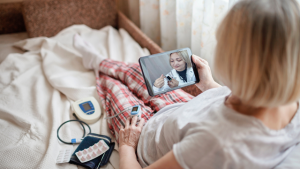Estimated reading time: 3 minutes
 Who knew that 2021 would be the year that we’d all be refreshing our cell phones every minute to book a COVID-19 Vaccine appointment, instead of doing the same gesture to secure concert tickets or a dinner reservation? The medical world has taken quite the spin this year and the most of the previous year due to the effects of the global pandemic. In-person doctors’ visitors are practically a thing of the past, and all medical transactions are processed right within the palms of our hands through digital health initiatives. Technology, with the help of IoMT is becoming widely more connected in order to cope with the increased burden that has fallen on medical professionals and facilities who are struggling to keep up with COVID-19 tests and vaccines being dispersed left and right. The Internet of Medical Things or IoMT is striving to enable interoperability across the broad spectrum of technologies to better encourage a positive flow of efficiency going forward.
Who knew that 2021 would be the year that we’d all be refreshing our cell phones every minute to book a COVID-19 Vaccine appointment, instead of doing the same gesture to secure concert tickets or a dinner reservation? The medical world has taken quite the spin this year and the most of the previous year due to the effects of the global pandemic. In-person doctors’ visitors are practically a thing of the past, and all medical transactions are processed right within the palms of our hands through digital health initiatives. Technology, with the help of IoMT is becoming widely more connected in order to cope with the increased burden that has fallen on medical professionals and facilities who are struggling to keep up with COVID-19 tests and vaccines being dispersed left and right. The Internet of Medical Things or IoMT is striving to enable interoperability across the broad spectrum of technologies to better encourage a positive flow of efficiency going forward.
Alleviating Industry Stress
With nursing and medical staff constantly on the clock to administer vaccinations and COVID-19 tests, there really isn’t any time for those staff members to always be looking in on their patients, that’s where IoMT-based devices come into the picture. Some IoMT devices are utilized to monitor patients’ well-being, including fitness trackers such as wristbands or smart watches, remote patient monitoring screens to dictate when medications should be administered and virtual consultations be recommended. All of these options require patient engagement to take place, leaving room for an advanced sense of trust, for the handling of personal medical data is heightened in this situation.
 In the case made for COVID-19, IoMT strategies have been accelerated to keep a loose eye on patient’s symptoms prior to and following a COVID-19 test or vaccination. Assistive technologies such as 5G, cloud computing, blockchain, and even AI can work to add to an already complex healthcare system, while also adding capability reach to the equation. Even before the pandemic, the adoption of IoMT was already growing rapidly, with the market valued at $44.5 billion in 2018 and predicted to surge into $254 billion by 2026.
In the case made for COVID-19, IoMT strategies have been accelerated to keep a loose eye on patient’s symptoms prior to and following a COVID-19 test or vaccination. Assistive technologies such as 5G, cloud computing, blockchain, and even AI can work to add to an already complex healthcare system, while also adding capability reach to the equation. Even before the pandemic, the adoption of IoMT was already growing rapidly, with the market valued at $44.5 billion in 2018 and predicted to surge into $254 billion by 2026.
Breaking down Barriers
When granted the option of Telehealth in the healthcare spectrum, many are finding that this innovation is breaking the concept of borders and restrictions, because there is now a greater sense of open access for those who desire and need medical attention. There is really no need for transportation or a mobility blockage now, because patients can receive routinely monitored care from the comfort of their homes. Mobility plays a huge role in the dispersal of healthcare by referring the sickest patients to an actual hospital bed, while handling the Telehealth care for those patients who don’t find themselves in the largest emergency situation.
Healthcare facilities are even able to cut down on costs by saving on a doctor/surgeon’s travel expenses, when they could just deliver the same amount of care from behind a screen. Mobile Healthcare functionalities allow for the furtherance of clinical grade monitoring of patients to help combat the shortage of at-home healthcare workers, especially protecting those who were already immune-compromised before this virus took hold.
Obviously, there are some barriers that are known to stand in the way and potentially halt operations from successfully occurring, including issues with internet infrastructure, connectivity and Wi-Fi, and perhaps even a user’s comfortability using the device/solution. A considerable amount of education and communication must be presented to the patient, to ensure that they are effectively utilized to get the best results.
A Collab of a Lifetime
Accessibility and usability are always important, in any situation, but especially when it comes with life-saving responsibilities. Going forward, the healthcare sector will need to prepare themselves on how to securely increase operations, even after the pandemic is seemingly “over.” Due to the uptick in remote healthcare activities and utilization of IoMT-based devices, there have been more connected devices, cloud-based applications, and cloud platforms in usage. Due to this increased activity, security risks have also increased and that brings a load of phishing and malware attacks, and don’t forget about data breaches. Healthcare IT teams have quite the daunting challenge lying ahead of them to ensure that network bandwidth, resilience, and security in the face of encouraging online care tactics such as Telehealth, telemedicine, remote workforces, and IoMT.

